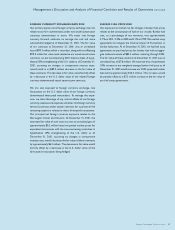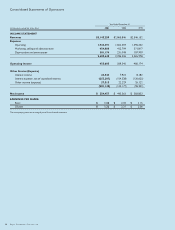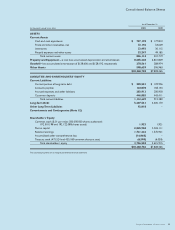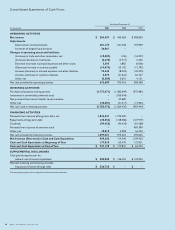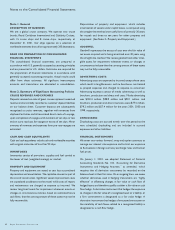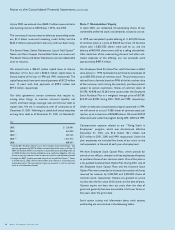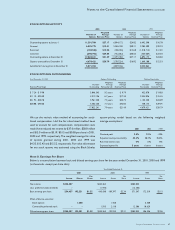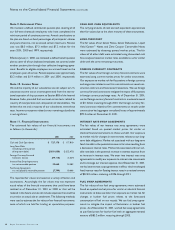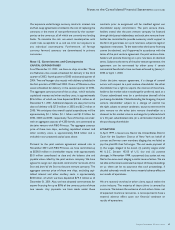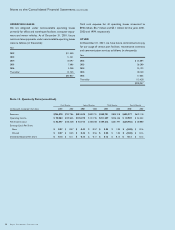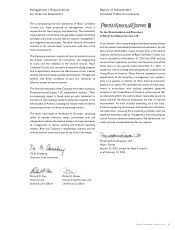Royal Caribbean Cruise Lines 2001 Annual Report Download - page 48
Download and view the complete annual report
Please find page 48 of the 2001 Royal Caribbean Cruise Lines annual report below. You can navigate through the pages in the report by either clicking on the pages listed below, or by using the keyword search tool below to find specific information within the annual report.
Notes to the Consolidated Financial Statements (continued)
46 Royal Caribbean Cruises Ltd.
In June 2000, we entered into a $625.0 million unsecured term
loan bearing interest at LIBOR plus 1.25%, due 2005.
The contractual interest rates on balances outstanding under
our $1.0 billion unsecured revolving credit facility and the
$625.0 million unsecured term loan vary with our debt rating.
The Senior Notes, Senior Debentures, Liquid Yield Option™
Notes and Zero Coupon Convertible Notes are unsecured.
The Senior Notes and Senior Debentures are not redeemable
prior to maturity.
We entered into a $264.0 million capital lease to finance
Splendour of the Seas and a $260.0 million capital lease to
finance Legend of the Seas in 1996 and 1995, respectively. The
capital leases each have semi-annual payments of $12.0 million
over 15 years with final payments of $99.0 million and
$97.5 million, respectively.
Our debt agreements contain covenants that require us,
among other things, to maintain minimum liquidity, net
worth, and fixed charge coverage ratio and limit our debt to
capital ratio. We are in compliance with all covenants as of
December 31, 2001. Following is a schedule of annual maturities
on long-term debt as of December 31, 2001 (in thousands):
Year
2002 $ 238,581
2003 434,959
2004 (1) 339,133
2005 (2) 1,627,473
2006 688,397
(1) Includes $51.8 million related to our Zero Coupon Convertible Notes. This
amount represents the $397.6 million accreted value of the notes as of May 18,
2004, the first date holders may require us to purchase any outstanding notes net
of a $345.8 million loan facility available to us to satisfy this obligation. We may
choose to pay any amounts in cash or common stock or a combination thereof.
(2) Includes the $697.2 million accreted value of our Liquid Yield Option™ Notes
as of February 2, 2005, the first date holders may require us to purchase any
outstanding notes. We may choose to pay any amounts in cash or common
stock or a combination thereof.
Note 7. Shareholders’ Equity
In April 2000, we redeemed all outstanding shares of our
convertible preferred stock and dividends ceased to accrue.
In 1999, we completed a public offering of 11,625,000 shares
of common stock at a price of $46.69 per share. Of the total
shares sold, 10,825,000 shares were sold by us, and the
balance of 800,000 shares were sold by a selling shareholder.
After deduction of the underwriting discount and other esti-
mated expenses of the offering, our net proceeds were
approximately $487.4 million.
Our Employee Stock Purchase Plan, which has been in effect
since January 1, 1994, facilitates the purchase by employees of
up to 800,000 shares of common stock. The purchase price is
derived from a formula based on 90% of the fair market value
of the common stock during the quarterly purchase period,
subject to certain restrictions. Shares of common stock of
33,395, 40,838 and 35,263 were issued under the Employee
Stock Purchase Plan at a weighted average price of $17.69,
$23.09 and $37.81 during 2001, 2000 and 1999, respectively.
Under an executive compensation program approved in 1994,
we will award to a trust 10,086 shares of common stock per
quarter, up to a maximum of 806,880 shares. We issued 40,344
shares each year under the program during 2001, 2000 and 1999.
Compensation expense related to our “Taking Stock in
Employees” program, which was discontinued effective
December 31, 2001, was $1.6 million, $2.1 million and
$3.3 million in 2001, 2000 and 1999, respectively. Under the
plan, employees are awarded five shares of our stock, or the
cash equivalent, at the end of each year of employment.
We have Employee Stock Option Plans, which provide for
awards to our officers, directors and key employees of options
to purchase shares of our common stock. One of the plans is
a tax-qualified Incentive Stock Option Plan. During 2001, one of
the Employee Stock Option Plans and the Incentive Stock
Option Plan were amended to increase the number of shares
reserved for issuance by 5,000,000 and 3,000,000 shares of
common stock, respectively. Options are granted at a price
not less than the fair value of the shares on the date of grant.
Options expire not later than ten years after the date of
grant and generally become exercisable in full over three or
five years after the grant date.
Stock option activity and information about stock options
outstanding are summarized in the following tables:



